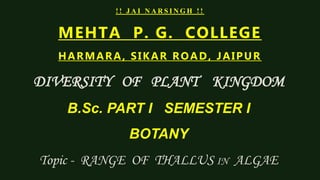
Algae Range of thallus BSc part I Semester I BOTANY.pptx
- 1. DIVERSITY OF PLANT KINGDOM B.Sc. PART I SEMESTER I BOTANY Topic - RANGE OF THALLUS IN ALGAE ! ! J A I N A R S I N G H ! ! MEHTA P. G. COLLEGE HARMARA, SIKAR ROAD, JAIPUR
- 2. AMIT KUMAR SHARMA Dept. OF BOTANY MCIT, HARMARA, JAIPUR RANGE OF THALLUS IN ALGAE
- 4. a) Freely moving in water by flagella. b) They are of many shapes – spherical, oblong or pear shaped and circular. Eg. Chlamydomonas c) Some are dorsi-ventrally differentiated Eg. Phacus d) The number of flagella may to one to more and it may be equal or unequal. 1. Unicellular Algae: It is of two types: A. Motile forms or flagellated forms
- 5. Euglena – one flagellum at its anterior Chlamydomonas – two flagella at its front end Heterochlorsis – two flagella and unequal Botrydiopsis – two flagella Trichloris – three flagella Carteria – four flagella Chloraster – five flagella Pocillomonas – six flagella Carteria Euglena Chlamydomonas
- 6. B. Non-motileor Non-flagellated or Coccoid Forms The unicellular non – flagellated forms are called coccoid forms. The cells are more or less round and bounded by rigid cell wall Eg. Chlorella and Chlorococcus The cell is elongated and spirally coiled structure Eg. Spirulina The cell is spindle in shape Eg. Closterium Closterium Chlorococcus CHLORELLA Spirulina
- 7. 2. Multicellular Algae forms: A group of individual cells of a species living in a habitat is called a colony. It is of flowing types:- A. Coenobium forms B. Aggregation forms C. Filamentous forms D. Siphonous forms E. Paranchymatous forms F. Equisetoid form
- 8. Coenobium is a colony of distinct shape, with a fixed number of cells arranged in a specific or distinct manner. A further evolution of the unicellular with independent individual cells types from occasional and indefinite type of colony. It is of two types - a. Motile colony forms b. Non Motile colonial forms A. Coenobium Forms
- 9. a. Motile colony forms: Volvox colony has many cells interconnected by protoplasmic connections. The surface of the colony is covered with mucilage. Gonium colony consists of 4 – 32 closely arranged Chlamydomonas type of cells surround by mucilaginous cells. Pandorina colony has 16 – 32 cells covered with a common mucilaginous sheath. Volvox Gonium Pandorina
- 11. b. Non Motile colonial forms The individual cells are non – flagellated as called non- motile The group of non-motile colonial cells as called Coenobium. Eg. Hydrodictyon, Pediastrum, Senedesmus etc. Hydrodictyon- Coenobium of Hydrodictyon consists of man cylindrical cells which are joined end to end like hexagons in shape. Hence the colony appears to be a net-like.
- 12. Pediastrum colony is disc shaped and is made of closely arranged cells. Scenedesmus colony consists of 4 – 8 variously shaped cells which are parellely arranged.
- 13. B. AGGREGATION FORMS: The aggregates are formed by the collection of single cells to make thallus. The aggregation of cells does not have a fixed number of cells and irregular shape or size of the colony like mass. They increase in the number of cells after division and the daughter cells remain in same gelatinous mass. The aggregates can be of three types: (a) Palmelloid Forms (b) Dendroid Forms (c) Rhizopodial Form
- 14. Tetraspora a. Palmelloid Forms Numerous non motile cells are embedded in a common mucilaginous matrix. E.g.- Palmella, Tetraspora, Chlorosaccus etc. Palmella
- 15. b. Dendroid forms: The thallus appears as tree like under the microscope. E.g.- Denobryon, Prasinocladus, Dendobryon etc. Dendobryon Dinobryon
- 16. c. Rhizopodial form: A colony in which the individual cells are linked together by rhizopodia is called rhizopodial forms or rhizopodial colony. Eg. Chlorachnion. Chlorachnion
- 17. C. FILAMENTOUS FORMS: An algal thallus cells are arranged in linear row. It formed through repeated cell divisions and all cells are joined end to end forming a chain or a thread. It is called a filament or filamentous form. The filaments may be of two types: a) Uniseriate filament or Unbranched filament b) Multiseriate filament or Branched filament
- 18. a). Uniseriate filament – The filament is made of single row of cells. Eg. Ulothrix, Oedogonium. b). Multiseriate filament – The cells are arranged in more than one linear row. Eg. Ulva Ulva ULOTHRIX Oedogonium
- 19. Branched filament or Multiseriate filament Filamentous thalli with lateral branches is called branched “filaments algae”. Scytonema Types of branched thalli a. Pseudo branches •In some algae, the filaments breaks at certain points due to the disintegration of cells. •The cells adjacent to the dead cells grow out of the mucilaginous sheath called “Pseudo branches”. Eg. Scytonema
- 20. True branches The lateral branches arise due to the transverse division of cells in lateral outgrowths. Eg. Cladophora Parenchymatous cells Eg. Ulva Pseudoparenchymatous cells Eg. Cladophora, Polysiphonia, Gracilaria
- 21. b. Heterotrichous forms •The filaments which contains both prostrate system and erect system is called “Heterotrichous form”. • Hetero – different; trichous – filament • The thallus was differentiated into creeping system and projecting system. • Creeping system – consists of branched filaments attached to the substratum. • Projecting system – arises from the creeping system and grows erect.
- 22. • Fritschiella – both creeping and erect equally developed • Coleochaete – creeping system – disc like and well developed. Projecting system – poorly developed • Drapernoldiopsis– projecting system well developed. Creeping system – poorly developed. Fritschiella Coleochaete Drapernoldiopsis
- 23. D. SIPHONOUS FORMS OR CEONOCYTIC ALGAE Elongated thallus without septation. The thallus cell is elongated which containsly nuclei, chromatophores, cytoplasm and a central narrow mvacuole. Eg. Vaucheria and Protosiphon
- 24. E. PARANCHYMATOUS FORMS The plant body of algae made up of parenchyma cells. During the cell =division septation leads to the formation of a parenchymatous body. E.g.- Chara, Ulva, Sargassum Chara Ulva Sargassum
- 25. THANK YOU!!!